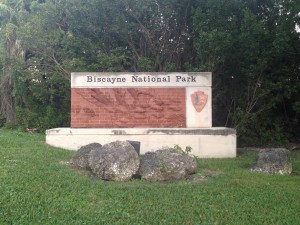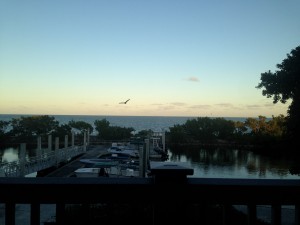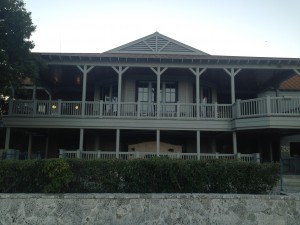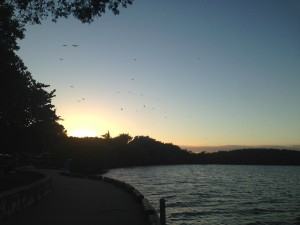
Biscayne gives visitors nature, adventure
HOMESTEAD, Fla.— You are sitting in a rocking chair, on a porch that wraps around a big, wooden house. You have a view of the vast ocean in front of you. It is warm outside, but it is not a sweltering heat as the ocean breeze provides a smooth wind that rocks your chair back and forth. You are not dreaming. You are at Biscayne National Park.
Biscayne National Park is located in South Florida, 21 miles east of Everglades National Park and on Biscayne Bay south of metropolitan Miami. It consists of 173,000 acres and was established as a national monument in 1968.
| The main entrance sign for Biscayne National Park in Homestead, Fla. has marine life textured into the tiles (Photos by Veronica Lopez). |  |
But the unique thing about this park is that 95 percent of it is underwater. In fact, it is the largest marine National Park in the system and boasts the third largest coral reef in the world, with the first being the Great Barrier Reef in Australia, and the second the Mesoamerican Barrier Reef.
The park’s rich history and wildlife offer much to its visitors, and has something for everyone that comes through its gates.
“I think that there’s a lot of things to learn for different kinds of people,” said Sommer Smith, 20, an intern for the national park from Daytona Beach, Fla. “We have things like cultural history, but we also have biology and interests for everyone. Everything can relate to something for them.”
With more than 600 species of fish and more than 300 species of birds, Biscayne National Park can be a dream for nature lovers.
 |
Visitors can enjoy a calming east view from a rocking chair on the porch of the Dante Fascell Visitor Center at Biscayne National Park. |
But Park Ranger Jay Johnstone, a Vermont native who has been working in the park service for 20 years, insists that the best way to make the most of your experience is to submerge yourself, literally.
“You need to get below the water,” said Johnstone. “You really need to stick your head in, whether it’s through a glass bottom bucket or snorkeling, you need to get below the waves, get below the surface, and that’s really the stories here at the park. See the fish, the rays, the sponge, the corals. That’s where you get the sense as to why it’s a special place.”
But getting below the surface has been difficult for visitors at Biscayne National Park. The concessionaire who ran the boat tours left the park in September 2013, and since then, park managers have been unable to offer that service to visitors.
“Their contract was still enforced, so we had to wait until the contract was over in order to even start writing the new contract or looking for someone else,” explained Mary Hammond, a volunteer at the park from Atlanta. “We’re now in that process of re-writing the contract where it’s more beneficial to the consumer and we’re going to be putting out bids, hopefully in 2015 to get a new concessionaire.”
As a result of the lack of a concessionaire, the park has stepped up its game by initiating their canoeing and kayaking programs.
 |
The east exterior of the Dante Fascell Visitor Center at Biscayne National Park. |
According to Hammond, visitors can spend two hours out in the bay in either a canoe or a kayak on Saturdays. On Sundays, rangers teach lessons for beginners that usually prepare them well enough to handle their own by the end of it. These programs are available by reservation and are free to the public.
Johnstone encourages visitors to visit the park with their own boats in order to make the experience your own.
“If you don’t have a boat, find a friend who has boat,” Johnstone advised. “This is all public land. You can come in with your own boat, you don’t need to have a ranger guide your boat experience, you can just get out to the islands or get on to the water with having a friend or a family member that can take you out.
“There are other companies, if you’re coming out of Matheson (Hammock) or Miami, which do boat tours out to the park. There are some options and that will change once we get a boat concessionaire, which is a high priority and it is restricting, no doubt about it, without having that alternative.”
One of the biggest projects that Biscayne National Park has been conducting in terms of conservation is an effort to eliminate the invasive lionfish species.
According to Hammond, they are not sure how the fish got there, but there are a few theories.
The first is that the fish came into the area with a hurricane. The second is that people who had them in their fish tanks threw them in a canal or in the ocean thinking they were doing no harm.
Unfortunately, the lionfish has no predator and the females lay 200 eggs a month, meaning that the entire coast is infested with the species that eat everything in sight. The park attempted to introduce the fish to the Goliath grouper, but to no avail.
“It’s a huge issue, because the coral reef is really one of the main resources that the park is tasked with protecting,” said Johnstone. “That is our front line. That is something that we have to do. It is essential. If we lose that battle, we have lost one of the most precious resources and so, that is going to be an ongoing battle for however long we’re here, because we will never get rid of all of them.”
Also, according to Johnstone, the park is continuing to monitor water quality and sea level rise with climate change.
“We have a lot of concerns, a lot of threats,” he said. “Whether it’s from agricultural run off, land fills, nuclear power plants, there’s a lot of issues associated with a lot of the local land use and how it impacts the watershed here. Sea level rise, climate change, that’s really one that trumps them all because rising water temperatures is going to impact the species of coral that can exist here, that’s going to impact the species of fish, of sea grasses, and we just don’t know what’s going to happen with that.”
| A sunset at Biscayne National Park. |  |
Despite the many concerns the park is dealing with at the moment, from lack of a boat tour concessionaire to invasive species, the park continues to be a paradise.
Visitors would not know that these problems exist if they were not public knowledge discussed by rangers. With marine mammals like dolphins and manatees visible up close, recreational fishing off the jetty, walking trails, hundreds of plant species, and a humble yet thorough and sophisticated visitor center, Biscayne National Park is definitely a worthwhile place to visit.
“Our park is full of people that just come out to have fun,” Hammond said. “They have birthday parties out here, they have picnics, and on Saturday and Sunday nights we actually have to kind of shove them out because they’re just here enjoying the park.”
If you are lucky enough to go out on the water, it will be an experience that you will never forget.
“They have a new experience,” Johnstone said. “And those new experiences lend themselves to some very, very deep connections. If you can take people out of their comfort zones, it heightens the senses a great deal and leads to very memorable experiences and in our case, we’re able to create very positive, deep memories with being on the water and just having that foreign experience that feels like an adventure. This park lends itself to the adventurous.”
If You Go
Address: 9700 SW 328th St., Homestead, Fla., 33033.
Drive to the end of the road until you get to Convoy Point and The Dante Fascell Visitor Center.
Visitor Information: 305-230- 7275.
Park Administrative Offices: 305-230- 1144.
Operating Hours and Seasons:
- Water portion open 24 hours a day.
- Convoy Point: daily, 7 a.m. to 5:30 p.m.
- Dante Fascell Visitor Center: daily, 9 a.m. to 5 p.m.
The park does not have an entrance fee, but there are fees for overnight tent camping and boat stays. Detailed information can be found at http://www.nps.gov/bisc/planyourvisit/feesandreservations.htm.
Guided canoe and kayak trip reservations are required, but will not be taken earlier than seven days in advance of any trip. Call 786-335- 2612.

Comments are Closed